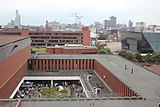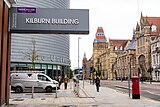
Castlefield is an inner-city conservation area in Manchester, North West England. The conservation area which bears its name is bounded by the River Irwell, Quay Street, Deansgate and Chester Road. It was the site of the Roman era fort of Mamucium or Mancunium which gave its name to Manchester. It was the terminus of the Bridgewater Canal, the world's first industrial canal, built in 1764; the oldest canal warehouse opened in 1779. The world's first passenger railway terminated here in 1830, at Liverpool Road railway station and the first railway warehouse opened here in 1831.

Wilmslow Road is a major road in Manchester, England, running from Parrs Wood northwards to Rusholme where it becomes the Oxford Road. The name of the road changes again to Oxford Street when it crosses the River Medlock before reaching Manchester city centre.

The Department of Computer Science at the University of Manchester is the longest established department of Computer Science in the United Kingdom and one of the largest. It is located in the Kilburn Building on the Oxford Road and currently has over 800 students taking a wide range of undergraduate and postgraduate courses and 60 full-time academic staff.
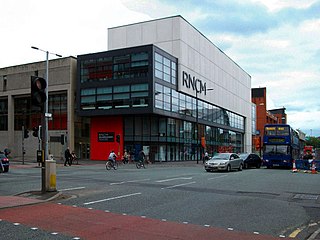
The Royal Northern College of Music (RNCM) is a conservatoire located in Manchester, England. It is one of four conservatoires associated with the Associated Board of the Royal Schools of Music. In addition to being a centre of music education, RNCM is one of the UK's busiest and most diverse public performance venues.
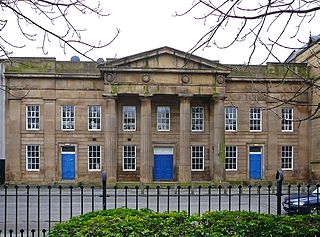
Chorlton-on-Medlock is an inner city area of Manchester, England.

Tom Kilburn was an English mathematician and computer scientist. Over his 30-year career, he was involved in the development of five computers of great historical significance. With Freddie Williams he worked on the Williams–Kilburn tube and the world's first electronic stored-program computer, the Manchester Baby, while working at the University of Manchester. His work propelled Manchester and Britain into the forefront of the emerging field of computer science.

Hulme is an inner city area and electoral ward of Manchester, England, immediately south of Manchester city centre. It has a significant industrial heritage.
Sir Frederic Calland Williams,, known as F.C. Williams or Freddie Williams, was an English engineer, a pioneer in radar and computer technology.

Old Trafford is an area of Trafford, Greater Manchester, England, which borders the cities of Manchester and Salford. It is located two miles (3.2 km) south-west of Manchester city centre in the historic county of Lancashire. The area represents the north-eastern tip of the parliamentary constituency of Stretford and Urmston. It is roughly delineated by two old toll gates: Brooks' Bar and Trafford Bar, to the east and west.

Ewan Christian (1814–1895) was a British architect. He is most frequently noted for the restorations of Southwell Minster and Carlisle Cathedral, and the design of the National Portrait Gallery. He was Architect to the Ecclesiastical Commissioners from 1851 to 1895. Christian was elected A RIBA in 1840, FRIBA in 1850, RIBA President 1884–1886 and was awarded the Royal Gold Medal in 1887.

The Alan Turing Building, named after the mathematician and founder of computer science Alan Turing, is a building at the University of Manchester, in Manchester, England. It houses the School of Mathematics, the Photon Science Institute and the Jodrell Bank Centre for Astrophysics (JBCA). The building is located in the Chorlton-on-Medlock district of Manchester, on Upper Brook Street, and is adjacent to University Place and the Henry Royce Institute.
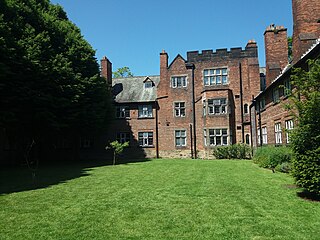
Hulme Hall is a traditional University of Manchester hall of residence situated at the Victoria Park Campus in Rusholme, Manchester, housing 300 students. It has a range of facilities including the John Hartshorne Centre: a 300 seat lecture theatre with attached seminar rooms; a library; Junior Common Room and study spaces; music room; old dining hall; the Victoria Park bar; and chapel.

Lancaster House in Whitworth Street, Manchester, England, is a former packing and shipping warehouse built between 1905 and 1910 for Lloyd's Packing Warehouses Limited, which had, by merger, become the dominant commercial packing company in early 20th century Manchester. It is in the favoured Edwardian Baroque style and constructed with a steel frame clad with granite at the base and Accrington red brick and orange terracotta. The back of the building is plain red brick. It is a Grade II* listed building as of 2 October 1974.
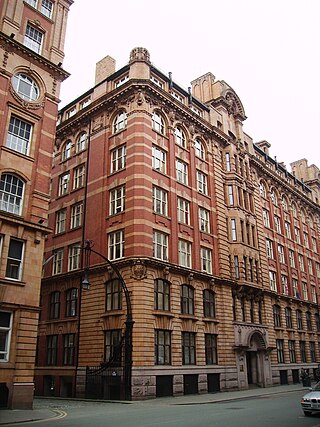
India House in Whitworth Street, Manchester, England, is a packing and shipping warehouse built in 1906 for Lloyd's Packing Warehouses Limited, which had, by merger, become the dominant commercial packing company in early-20th century Manchester. It is in the favoured Edwardian Baroque style and is steel-framed, with cladding of buff terracotta and red brick with buff terracotta dressings. It is a Grade II* listed building as of 2 October 1974.

The Church of St George, Chester Road, Hulme, Manchester, is an early Gothic Revival church by Francis Goodwin, built in 1826–8. It was restored in 1884 by J. S. Crowther. It was designated a Grade II* listed building on 3 October 1974.
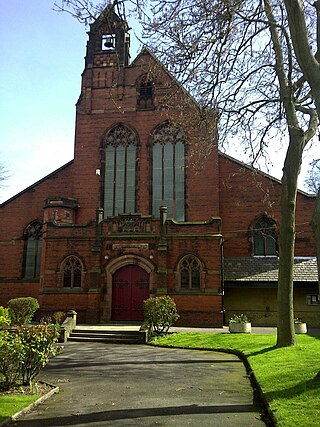
Christ Church in Lloyd Street North, Moss Side, Manchester, England, is an Anglican church of 1899–1904 by W. Cecil Hardisty. It was designated a Grade II* listed building on 24 April 1987.

The British Muslim Heritage Centre, formerly the GMB National College, College Road, Whalley Range, Manchester, England, is an early Gothic Revival building. The centre was designated a Grade II* listed building on 3 October 1974.

Grove House, on Oxford Road, Chorlton-on-Medlock, Manchester, England, is an early Victorian building, originally three houses, of 1838–40. It is a Grade II* listed building as of 18 December 1963.

The Greek Orthodox Church of the Annunciation, Manchester is a Greek Orthodox church in Salford, Greater Manchester. Completed in 1861 in a classical architectural style, it is the oldest purpose-built Greek Orthodox church in England and since 1980, a grade II listed building for its “special architectural or historic interest”. As of 2017 the church provides liturgies on Sundays and acts as a hub for a community of an estimated 2,500 Greek diaspora, particularly Greek Cypriots, British Cypriots and Greek students in Manchester.

J. Lewis Womersley CBE, FRIBA, FRTPI, Hon. LL.D and MA was a British architect and town planner best known for his work as City Architect for Sheffield, leading the team that created the Gleadless Valley, Hyde Park and Park Hill estates. Womersley's passion was "incorporating buildings, roads, paths, play-grounds, schools and superb landscaping as the complete architectural environment."


